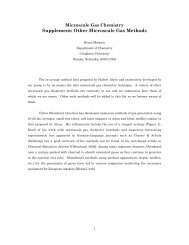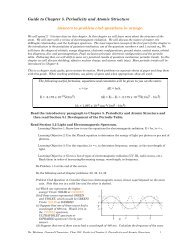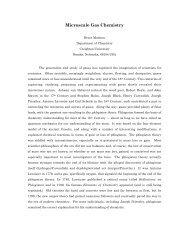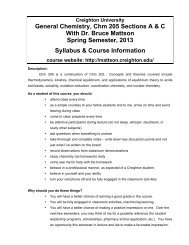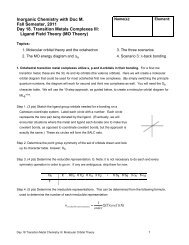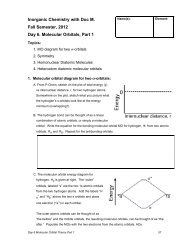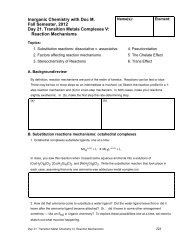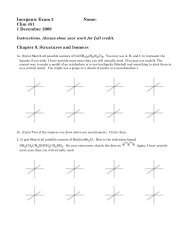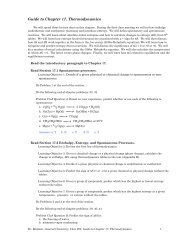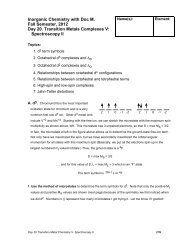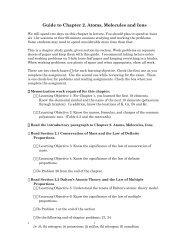Like-dissolves-like self test ANSWERS - Mattson
Like-dissolves-like self test ANSWERS - Mattson
Like-dissolves-like self test ANSWERS - Mattson
You also want an ePaper? Increase the reach of your titles
YUMPU automatically turns print PDFs into web optimized ePapers that Google loves.
<strong>Like</strong>-<strong>dissolves</strong>-<strong>like</strong> <strong>self</strong> <strong>test</strong><br />
1. Use the principle of similar forces between solute and solvent to predict the <strong>like</strong>lihood that the<br />
following solutes will dissolve in polar and non-polar solvents. In each cell, circle “Yes” if the solute<br />
is <strong>like</strong>ly to be soluble, “No” if is not <strong>like</strong>ly to be soluble, and “Maybe” if there are reasons that seem to<br />
conflict. Provide an explanation which should include how you have categorized the solute (ionic,<br />
covalent-molecular, metallic, network covalent).<br />
Solute* Solvent (water) Solvent (non-polar) Explanation:<br />
1. K 2 SO 4 Yes No Maybe Yes No Maybe<br />
2. AgCl Yes No Maybe Yes No Maybe<br />
3. SiCl 4 Yes No Maybe Yes No Maybe<br />
4. Cu Yes No Maybe Yes No Maybe<br />
5. CH 2 O Yes No Maybe Yes No Maybe<br />
6. HOCl Yes No Maybe Yes No Maybe<br />
7. SiC** Yes No Maybe Yes No Maybe<br />
8. CH 3 NH 2 Yes No Maybe Yes No Maybe<br />
9. Ca(NO 3 ) 2 Yes No Maybe Yes No Maybe<br />
10. PbSO 4 Yes No Maybe Yes No Maybe<br />
11. NH 4 C 2 H 3 O 2 Yes No Maybe Yes No Maybe<br />
12. CH 3 CH 2 CH 2 OH Yes No Maybe Yes No Maybe<br />
13. P 4 Yes No Maybe Yes No Maybe<br />
14. HCl Yes No Maybe Yes No Maybe<br />
15. CrCl 3 Yes No Maybe Yes No Maybe<br />
16. Al 2 (CO 3 ) 3 Yes No Maybe Yes No Maybe<br />
17. SF 2 Yes No Maybe Yes No Maybe<br />
18. CO Yes No Maybe Yes No Maybe<br />
*central atom underlined<br />
** network covalent<br />
2. Which of the water-soluble solutes form electrolytes in solution?<br />
3. If a solute and solvent have very similar intermolecular forces and are of the same phase (s, l, g),<br />
they may be miscible, that is, they may form solutions of any proportion without one being only of<br />
limited solubility in the other. For example, nitrogen and oxygen are miscible and methanol<br />
(CH 3 OH) and water are miscible. What is the range of values for mole fraction for miscible solutions?<br />
What is the range of values for mass percent for miscible solutions?<br />
4. Name the solutes except for CH 2 O, CH 3 NH 2 , for CH 3 CH 2 CH 2 OH, which are named using organic<br />
nomenclature rules that we have not covered in Chm 203. As for the others, be sure you can name<br />
substances such as these.<br />
Answers available at the course website.
<strong>Like</strong>-<strong>dissolves</strong>-<strong>like</strong> <strong>self</strong> <strong>test</strong> <strong>ANSWERS</strong><br />
1.<br />
Solute* Solvent<br />
(water)<br />
Solvent<br />
(non-polar)<br />
Explanation:<br />
1. K 2 SO 4 Yes No This is an ionic compound, so you need to use the<br />
Solubility Rules for ionics in water. In this case, “All<br />
Group 1 salts are soluble in water.” Ionic compounds are not<br />
soluble in non-polar solvents (lecture notes)<br />
2. AgCl No No This is an ionic compound, so you need to use the<br />
Solubility Rules for ionics in water. In this case, “All<br />
halide salts are soluble in water, except AgX, PbX 2 , and<br />
Hg 2 X 2 , where X - = Cl - , Br - , I - . .” Ionic compounds are not<br />
soluble in non-polar solvents (lecture notes)<br />
3. SiCl 4 No Yes This is a covalent-molecular (non-metal + non-metal), so we<br />
1. Sketch the Lewis dot structure and if there are electron<br />
pair groups (“E” groups), the compound is polar; if there are<br />
no E groups, the compound is most <strong>like</strong>ly non-polar. This<br />
compound has 4 bonding groups and no electron pair groups<br />
(AB 4 ) so it is non-polar.<br />
4. Cu No No Rule: Metals are not soluble in any normal solvent.<br />
(Don’t confuse reactivity with dissolving! For example, Cu<br />
will react with HNO 3 (aq) and it may look a bit <strong>like</strong> it’s<br />
dissolving, but we are NOT forming Cu(aq) which is what it<br />
means to dissolve in water. (We get Cu +2 (aq) in the case of<br />
HNO 3 + Cu(s).)<br />
5. CH 2 O Yes Maybe This is a covalent-molecular (non-metal + non-metal), so we<br />
1. Sketch the Lewis dot structure and if there are electron<br />
pair groups (“E” groups), the compound is polar; if there are<br />
no E groups, the compound is most <strong>like</strong>ly non-polar. The C<br />
has AB 3 and the O has ABE 2 so the compound is polar<br />
according to the oxygen anyway. For non-polar solvents,<br />
the answer is “maybe” because the C is AB 3 .<br />
6. HOCl Yes No This is a covalent-molecular and a weak acid. 1. Sketch the<br />
Lewis dot structure: O is AB 2 E 2 so it is polar.<br />
7. SiC** No No Rule: Network covalents are insoluble in all solvents.<br />
8. CH 3 NH 2 Yes Maybe This is a covalent-molecular (non-metal + non-metal), so we<br />
1. Sketch the Lewis dot structure and if there are electron<br />
pair groups (“E” groups), the compound is polar; if there are<br />
no E groups, the compound is most <strong>like</strong>ly non-polar. The C<br />
has AB 3 and the N has AB 3 E so the compound is polar<br />
according to the N anyway. For non-polar solvents, the<br />
answer is “maybe” because the C is AB 4 .<br />
9. Ca(NO 3 ) 2 Yes No Ionic compound: Solubility Rules state that all nitrates are<br />
soluble.<br />
10. PbSO 4 No No Ionic compound: Solubility Rules state that all sulfates are<br />
soluble except BiSO 4 , Hg 2 SO 4 , and PbSO 4 .<br />
11. NH4C2H3O2 Yes No Ionic compound: ammonium acetate. Solubility Rules state<br />
that all ammonium salts are soluble. Another solubility<br />
rule states that all acetates are soluble.<br />
12.<br />
Maybe Yes This is a covalent-molecular with three C atoms that are<br />
non-polar AB4 centers and one O that is polar: AB2E2 .<br />
CH 3 CH 2 CH 2 OH<br />
Taken together, it is mostly non-polar, so we guess “Yes” for<br />
solubility in non-polar solvents, but maybe for solubility in<br />
water.
13. P 4 No Yes You can skip this one, it is tricky. Look up the structure of<br />
P 4 and you will see that it is perfectly symmetric, <strong>like</strong> N 2 ,<br />
which is non-polar.<br />
14. HCl Yes No You should recall that HCl forms a strong acid in water.<br />
Otherwise, you will still predict it is a polar covalentmolecular.<br />
15. CrCl 3 Yes No Ionic compound. Solubility Rule: All chlorides are soluble<br />
except AgCl, Hg 2 Cl 2 and PbCl 2 .<br />
16. Al 2 (CO 3 ) 3 No No Ionic compound. Solubility Rule: All carbonates are<br />
insoluble except Group I and ammonium.<br />
17. SF 2 Yes No Covalent-molecular, AB 2 E 2 .<br />
18. CO Yes No We predict that CO should be polar and it is. Nevertheless,<br />
CO is a gas and is not very soluble in any liquid solvent.<br />
2. Which of the water-soluble solutes form electrolytes in solution? K 2 SO 4 , HOCl is a weak acid and<br />
forms a weakly electrolytic solution similar to acetic acid; CH 3 NH 2 (I wouldn’t expect you to be able<br />
to predict this one prior to Chap 14), Ca(NO 3 ) 2 , NH 4 C 2 H 3 O 2 , HCl, and CrCl 3 .<br />
3. What is the range of values for mole fraction for miscible solutions? Answer: 0 – 1. What is the<br />
range of values for mass percent for miscible solutions? Answer: 0% - 100%.<br />
4. Names:<br />
Solute Name Naming rule used<br />
1. K 2 SO 4 Potassium sulfate Ionic naming rules<br />
2. AgCl Silver chloride Ionic naming rules<br />
3. SiCl 4 Silicon tetrachloride Covalent-molecular naming rules<br />
4. Cu Copper Name of element<br />
6. HOCl Hypochlorous acid Naming oxyacids<br />
7. SiC** Silicon carbide Covalent-molecular naming rules<br />
9. Ca(NO 3 ) 2 Calcium nitrate Ionic naming rules<br />
10. PbSO 4 Lead(II) sulfate Ionic naming rules. Note that we must specify oxidation state<br />
for the metal except for Groups I and II and aluminum.<br />
11. NH 4 C 2 H 3 O 2 Ammonium acetate Ionic naming rules. Note: Ionic compounds do not always have<br />
to contain metal cations! Ammonium is a good cation without<br />
any metals.<br />
13. P 4 Phosphorus Name of element<br />
14. HCl Hydrogen chloride Covalent-molecular naming rules. Note: When HCl is<br />
dissolved in water, it is called “hydrochloric acid,” but when it<br />
is not in water, it is a gas and is named using the covalentmolecular<br />
naming rules.<br />
15. CrCl 3 Chromium(III) chloride Ionic naming rules. Note that we must specify oxidation state<br />
for the metal except for Groups I and II and aluminum.<br />
16. Al 2 (CO 3 ) 3 Aluminum carbonate Ionic naming rules.<br />
17. SF 2 Sulfur difluoride Covalent-molecular naming rules.<br />
18. CO Carbon monoxide Covalent-molecular naming rules.



